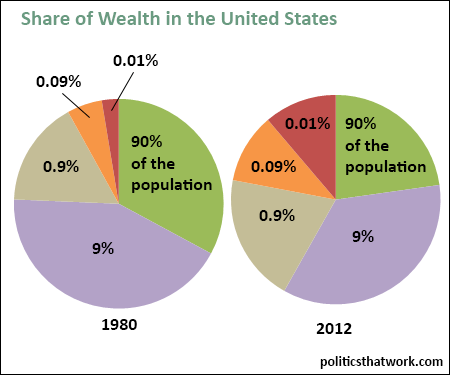Change in the Division of Wealth Between 1980 and 2012
Description: These two pie charts show how the wealth in the United States is divided up. The pie chart on the left shows the division in 1980 and the pie chart on the right shows the division in 2012. The green wedges show the portion of the wealth that is held by the least wealthy 90% of the population, the purple wedge shows the portion held by the 90th to 99th percentile, the grey wedge represents the share held by the top 1%, excluding the top 0.1%, the orange wedge shows the top 0.1% excluding the top 0.01% and the maroon wedge shows the portion of the wealth held by the wealthiest 0.01% of the population.
Related blog post: Inequality in AmericaDiscussion: The share of the wealth held by the bottom 90% of us shrunk from 32.9% to 22.8% between 1980 and 2012. The share of the next 9% of us also shrunk- from 42.8% to 35.4%. The share held by each segment of the top 1% increased. The share held by the bottom nine tenths of the top 1% increased from 16.3% to 19.8%, the share held by the bottom nine tents of the top 0.1% increased from 5.4% to 10.8%, and the share of the top 0.01% more than quadrupled from 2.6% to 11.2%.
To give a point of reference, in 2012, the top 1% was those who have a net worth of $3,964,000 or more. The top 0.1% starts at $20 million and the top 0.01% starts at $111 million.
This data is drawn from the data accompanying Emmanuel Saez and Gabriel Zucman's paper Wealth Inequality in the United States since 1913: Evidence from Capitalized Income Tax Data (2014) available at the link on the left.
This chart shows the change in each bracket's share of the nation's wealth. You can also see the change in each bracket's real absolute wealth here.See more graphs about: Wealth Inequality
